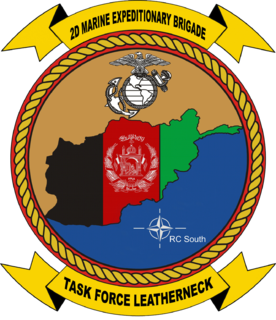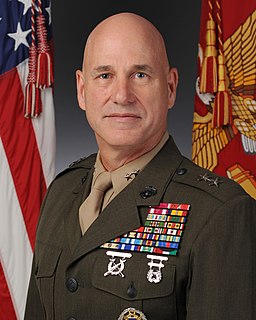
The International Security Assistance Force (ISAF) was a multinational military mission in Afghanistan from 2001 to 2014. It was established by United Nations Security Council Resolution 1386 pursuant to the Bonn Agreement, which outlined the establishment of a permanent Afghan government following the U.S. invasion in October 2001. ISAF's primary goal was to train the Afghan National Security Forces (ANSF) and assist Afghanistan in rebuilding key government institutions; however, it gradually took part in the broader war in Afghanistan against the Taliban insurgency.

The Afghan National Army was the land warfare branch of the Afghan Armed Forces. The Army's roots could be traced back to the early 18th century when the Hotak dynasty was established in Kandahar followed by Ahmad Shah Durrani's rise to power. It was reorganized in 1880 during Emir Abdur Rahman Khan's reign. Afghanistan remained neutral during the First and Second World Wars. From the 1960s to the early 1990s, the Afghan Army was equipped by the Soviet Union.

1st Battalion, 2nd Marines (1/2) is an infantry battalion in the United States Marine Corps based out of Marine Corps Base Camp Lejeune, North Carolina, consisting of approximately 900 Marines and sailors. The battalion, callsign "Typhoon'" falls under the command of the 2nd Marine Regiment and the 2nd Marine Division.

Below is the disposition and structure of international military forces that were participating in the War in Afghanistan in November 2012, listing deployed units under the command of the International Security Assistance Force (ISAF), which controlled both combat and reconstruction operations. During its existence from 2001 to 2014, ISAF comprised units from many countries. In this article, units are assumed to be from the United States unless otherwise stated. This list is a rough and unofficial listing of units and formations.
Combined Joint Task Force – 76 (CJTF-76) was a US led subordinate formation of Combined Forces Command – Afghanistan (CFC-A) headquartered in Kabul, Afghanistan. It was active from the time CFC-A stood up to the time the International Security Assistance Force (ISAF) took full command of the coalition military operations in Afghanistan in October 2006. CFC-A reported in its turn to United States Central Command. While CFC-Afghanistan was supposed to have inactivated sometime after November 30, 2006, CJTF-76 remained as a headquarters for ISAF's Regional Command East. CJTF-76 was replaced by Combined Joint Task Force 82, led by the 82nd Airborne Division, in the middle of 2007.

Operation Herrick was the codename under which all British operations in the War in Afghanistan were conducted from 2002 to the end of combat operations in 2014. It consisted of the British contribution to the NATO-led International Security Assistance Force (ISAF), and support to the American-led Operation Enduring Freedom (OEF), within the central Asian country.

The 2nd Marine Expeditionary Brigade is a brigade of the United States Marine Corps. It is part of II Marine Expeditionary Force. It advertises itself as a "middleweight" crises response force of choice in the European and Southern Command Areas of Operation. It is able to "operate independently, as a service component, or to lead a Joint Task Force". Self-sufficient and interoperable, the 2nd Marine Expeditionary Brigade possesses a mix of command and control, combat power and specialized logistics. Operating as part of the greater Marine Corps team and with support from the United States Navy and other services, it can provide operational reach.

The Helmand province campaign was a series of military operations conducted by the International Security Assistance Force (ISAF) forces against Taliban insurgents and other local groups in the Helmand Province of Afghanistan. Their objective was to control a province that was known to be a Taliban stronghold, and a center of opium production. None of the ISAF's intended strategic and political objectives were achieved in the long term.

Combat Logistics Battalion 6 (CLB-6) is a logistics battalion of the United States Marine Corps. Nicknamed "Red Cloud," the unit is based at Marine Corps Base Camp Lejeune, North Carolina and fall under the command of Combat Logistics Regiment 2 and the 2nd Marine Logistics Group..

Camp Leatherneck was a 1,600 acre United States Marine Corps base in Helmand Province, Afghanistan. The site was mostly in Washir District and was conjoined with Camp Bastion, which was the main British military base in Afghanistan and Camp Shorabak which initially was the main Afghan section however the three sites were joined together under the name of 'Camp Shorabak' in 2014.

Task Force Leatherneck or MEB-Afghanistan is a Marine Air-Ground Task Force currently operating in Helmand Province, Afghanistan. The name was originally given to the 2nd Marine Expeditionary Brigade during its 2009-10 operations for Operation Enduring Freedom as part of Regional Command South. It is also the name used by the 1st Marine Division and 2nd Marine Division during their deployments to Afghanistan. Task Force Leatherneck is commanded by Brigadier General Lawrence D. Nicholson with the command element at Camp Leatherneck. The task force took over the battlespace from Special Purpose MAGTF-Afghanistan on May 29, 2009. In July 2009, Task Force Leatherneck participated in Operation Strike of the Sword, the largest Marine Corps operation since the Battle of Fallujah, and then in February 2010 an even larger battle, the largest of the Afghan Campaign, Operation Moshtarak.
Train Advise Assist Command – East was a multinational military formation, part of NATO's Resolute Support Mission within Afghanistan. Until 2014 it was designated Regional Command East, part of the International Security Assistance Force (ISAF). The United States Army provided the force headquarters. The command headquarters was located in Laghman Province.
Train Advise Assist Command – South was a multinational military formation, part of NATO's Resolute Support Mission within Afghanistan. Prior to 2014 it was designated Regional Command South, under the International Security Assistance Force (ISAF).

Operation Moshtarak, also known as the Battle of Marjah, was an International Security Assistance Force (ISAF) pacification offensive in the town of Marjah, Helmand Province, Afghanistan. It involved a combined total of 15,000 Afghan, American, British, Canadian, Danish, and Estonian troops, constituting the largest joint operation of the War in Afghanistan up to that point. The purpose of the operation was to remove the Taliban from Marja, thus eliminating the last Taliban stronghold in central Helmand Province. The main target of the offensive was the town of Marjah, which had been controlled for years by the Taliban as well as drug traffickers.

Lieutenant General Richard P. Mills is a retired United States Marine Corps officer, who served as commander of the Marine Forces Reserve from 2013 to 2015 and Marine Forces North, headquartered at the Marine Corps Support Facility New Orleans. Previously he was Deputy Commandant for Combat Development and Integration and Commanding General, Marine Corps Combat Development Command in Quantico, Virginia, and, prior to that assignment, was commander of the I Marine Expeditionary Force (Forward)/Regional Command Southwest in Afghanistan.
Task Force Helmand was the name given to a military unit of the International Security Assistance Force in Helmand Province, Afghanistan. Task Force Helmand was part of Regional Command Southwest and consisted primarily of personnel from the British Armed Forces, as well as contribution from NATO allies Denmark and Estonia. It was established in April 2006, which coincided with the deployment of Operation Herrick 4.

Daniel Daejin Yoo is a U.S. Marine Major General and former commander of United States Marine Corps Forces Special Operations Command. He is the first Korean-American general in the United States Marine Corps.
This article summarizes the history of the War in Afghanistan (2001–2021).

Paul W. Brier is a retired United States Marine Corps major general. A combat veteran of the Persian Gulf, Iraq, and Afghanistan wars, he retired on 31 December 2016, completing 36 years of military service. He holds a BS in Civil Engineering from the Virginia Military Institute and a Master of Strategic Studies from the U.S. Army War College. A 2012 CAPSTONE Fellow at the National Defense University, he is a graduate of the Defense Resources Management Institute, Naval Postgraduate School; Air War College; Joint Forces Staff College; and Marine Corps Command and Staff College.













